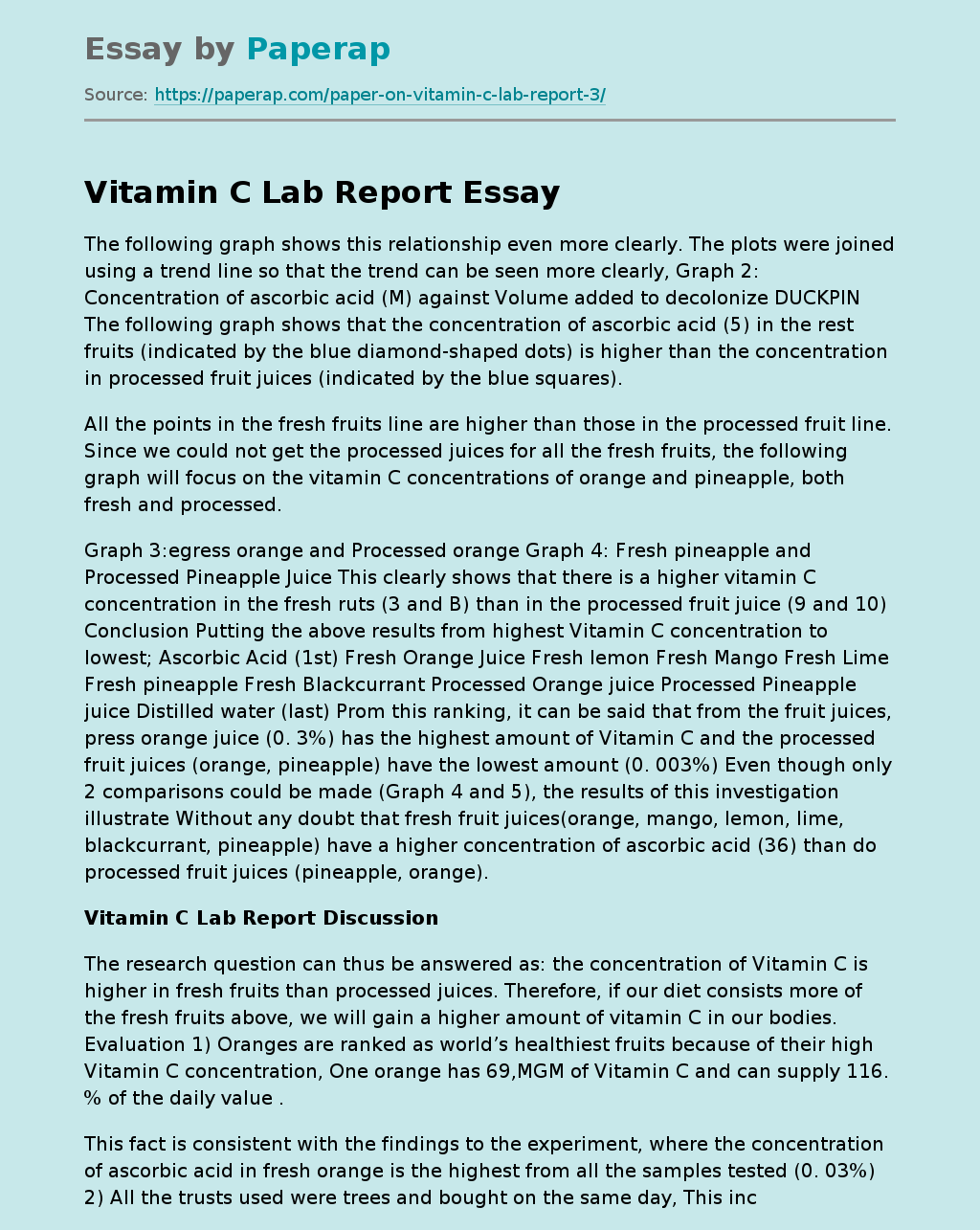The following graph shows this relationship even more clearly. The plots were joined using a trend line so that the trend can be seen more clearly, Graph 2: Concentration of ascorbic acid (M) against Volume added to decolonize DUCKPIN The following graph shows that the concentration of ascorbic acid (5) in the rest fruits (indicated by the blue diamond-shaped dots) is higher than the concentration in processed fruit juices (indicated by the blue squares).
All the points in the fresh fruits line are higher than those in the processed fruit line.
Since we could not get the processed juices for all the fresh fruits, the following graph will focus on the vitamin C concentrations of orange and pineapple, both fresh and processed.
Graph 3:egress orange and Processed orange Graph 4: Fresh pineapple and Processed Pineapple Juice This clearly shows that there is a higher vitamin C concentration in the fresh ruts (3 and B) than in the processed fruit juice (9 and 10) Conclusion Putting the above results from highest Vitamin C concentration to lowest; Ascorbic Acid (1st) Fresh Orange Juice Fresh lemon Fresh Mango Fresh Lime Fresh pineapple Fresh Blackcurrant Processed Orange juice Processed Pineapple juice Distilled water (last) Prom this ranking, it can be said that from the fruit juices, press orange juice (0.
3%) has the highest amount of Vitamin C and the processed fruit juices (orange, pineapple) have the lowest amount (0. 003%) Even though only 2 comparisons could be made (Graph 4 and 5), the results of this investigation illustrate Without any doubt that fresh fruit juices(orange, mango, lemon, lime, blackcurrant, pineapple) have a higher concentration of ascorbic acid (36) than do processed fruit juices (pineapple, orange).
Vitamin C Lab Report Discussion
The research question can thus be answered as: the concentration of Vitamin C is higher in fresh fruits than processed juices. Therefore, if our diet consists more of the fresh fruits above, we will gain a higher amount of vitamin C in our bodies. Evaluation 1) Oranges are ranked as world’s healthiest fruits because of their high Vitamin C concentration, One orange has 69,MGM of Vitamin C and can supply 116. % of the daily value .
This fact is consistent with the findings to the experiment, where the concentration of ascorbic acid in fresh orange is the highest from all the samples tested (0. 03%) 2) All the trusts used were trees and bought on the same day, This increased reliability of the results since the age of the fruit may affect Vitamin C content 3) Waterway used as a control in the experiment to ensure the fact that only items with vitamin C can decolonize DUCKPIN_ 4) A syringe was used to drop the fruit juices in to the test tubes since a pipette was not available.
The problem with a syringe is that if too much pressure is applied, the entire solution can be poured out and it has an uncertainty of (to CACM). Maybe it would have been better to use a burette, which also has a lower uncertainty (3) 5) We were told that the concentration Of ascorbic acid provided was C. We were not however sure because we did not see it being made. In this case, we should have made the solution to that concentration ourselves, or the lab technician should have made it in front of us. ) A limitation of this investigation was that the maturity Stage Of the fruits was not determined. Vitamin C concentration creases during the ripening process. Unripe fruits have more ascorbic acid than the ripe ones. Since the ripening stage was not informed, the ascorbic acid concentration could have varied and therefore affected the results of the experiment. Even the position of the fruits on the tree was not known; sunlight exposure enhances vitamin C levels.
Maybe some fruits were on the shadier side showing low levels of vitamin C. 7) The observations in this experiment were made solely by the eye, There was thus huge room for human error, as sometimes, DVD drops could seem one drop. In this case, two people could have en used to watch the drops and increase reliability of results 8) Blackcurrant is a fresh fruit which has a very high concentration of vitamin C. However the results of this investigation showed otherwise.
This may indicate a shortcoming in the experiment because this fruit was the only one which did not show a high concentration of vitamin C. Maybe the juice became a bit too dilute. This could have been rectified if time had allowed. Due to time constraints, this experiment was only carried out once. In order to obtain reliable results however, the experiment should have been carried out three times, and the average volume of squids required to decolonize could have been Obtained, giving a more realistic picture of the concentrations. ) Another limitation was that besides orange and pineapple, the processed juices Of Other fresh fruits were not available and so they could not be directly compared to each other. However, the results did show that processed fruit juices had low Vitamin C content. 10) If time would have permitted, the experiment for 7, 9 and 10 should have been continued so as to obtain the exact end point when the DUCKPIN got decolonize and therefore get the exact concentration of ascorbic acid in those liquid tests.
Vitamin C Lab Report. (2019, Dec 05). Retrieved from https://paperap.com/paper-on-vitamin-c-lab-report-3/

